Organic Seed Database Launches in October
To address the lack of availability to organic seed, a new
resource will allow organic farmers to easily search for local or online
organic-seed retailers.
By Rachael Brugger, Senior Associate Web
Editor August 24, 2012
Farmers can perform an online search for organic seed retailers with the Organic Seed Finder, which launches in October 2012.
One of the first hurdles you’re likely to face as an organic farmer is as
small as a seed—actually, it is a seed—and it can be a huge obstacle to your operation. An astounding 80 percent of U.S. organic farmers don’t have organic seed readily available to them, according to survey of certified-organic farmers in 45 states, cited in the Organic Seed Alliance’s “State of Organic Seed” report.
“USDA’s National Organic Program requires the use of organically produced seed when commercially available. But because the organic seed sector was in its infancy when the program began—meaning, the supply couldn't fully meet demand—the rules allow for the use of untreated conventional (non-organic) seed when an equivalent organic form is unavailable,” says Kristina Hubbard, OSA’s director of advocacy and communications
To help meet the needs of organic growers and get them on track to go fully organic from seed to fruit, the Association of Official Seed Certifying Agencies, with support from the OSA, on Oct. 1, 2012, will launch the Organic Seed Finder, an online database of organic seed vendors. The database provides a comprehensive listing of organic field-crop, vegetable and herb seeds that allows users to perform an easy search based on their desired crop attributes and connect with seed vendors in their area or elsewhere.
“The organic community has been calling for a new organic seed database for several years,” says Hubbard, who has helped manage the project since it was initiated last year. “Furthermore, the National Organic Standards Board recommended a database in 2005 and reiterated this recommendation again in 2008.”
With the database, a seed search can take a farmer a matter of minutes—saving them time to attend to other important farm matters. First, the farmer selects from the seed finder’s homepage the type of seed he’s looking for: field crop, vegetable or herb. He then selects the crop variety he wants—for example, tomatoes. When he clicks on “Tomatoes,” he is then presented with a checklist of attributes he wants his tomatoes to have: type (cherry, paste, slicer, et cetera.), color, days to maturity and resistance to diseases, such as to spotted wilt virus or
yellow leaf curl. Each available crop has a unique list of attributes.
Once the farmer selects his desired attributes, he’s presented with a list of varieties, which includes the name of the business selling the seeds and when the listing for that seed was last updated. (The seed database will not present real-time availability of organic seeds.) If a variety is temporarily sold out but the vendor plans to continue sales once the seed is in stock, this will be indicated. The farmer can then print off this list to add to his files or click on the seed variety to be redirected to the vendor’s website or contact information.
The database will be managed by ASOSCA, and staff will be on call to help users with their seed searches. For purposes of the launch, the seed finder will only catalog organic seed varieties, but the system is being developed to easily adapt to seed industry’s needs, says AOSCA CEO Chet Boruff. Developers have already considered expansion
options, including catalogs for heirloom and non-GMO seeds, but
they’re waiting to receive industry feedback before implementing any
expansions.
The Organic Seed Finder will go live at www.organicseedfinder.org on Oct. 1, 2012. [Note: You will not be able to access the database website until the launch date.]
In the days leading up to the launch, AOSCA is inviting farmers, seed vendors and other stakeholders to provide input on the type of seed you would like to see cataloged in the Organic Seed Finder’s database. Send your questions about the Organic Seed Finder or its October launch to [email protected]
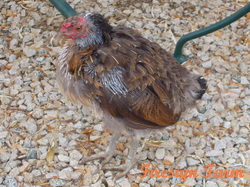
Moulting - how, when and why chickens moult During autumn, many household poultry keepers, particularly people keeping poultry for the first time, are puzzled because egg production markedly declines or ceases despite their laying birds appearing healthy. This seasonal decline in egg production occurs when birds go into a condition known as the 'moult'. Moulting is the process of shedding and renewing feathers. During the moult, the reproductive physiology of the bird has a complete rest from laying and the bird builds up its body reserves of nutrients. The provision of new feathers or a coat (a feature inherent in most animals) is a natural process, designed by nature to maintain a bird's ability to escape enemies by flight and better protect against cold winter conditions. Under usual conditions, adult birds moult once a year. Some may moult twice in one year and, rarely, once in two years. The pullet The chick goes through one complete and three partial moults during its growth to point of lay. Generally, complete moulting occurs from 1-6 weeks of ag, and partial moulting at 7-9 weeks, 12-16 weeks and 20-22 weeks. During this final moult, the stiff tail feathers grow. The laying hen Mature birds normally undergo one complete moult a year, usually in autumn. However, this can depend on the time of the year that the bird started laying. Natural moulting usually begins sometime during March or April and should be completed by July when egg production recommences. The three main factors that bring about moulting are: - physical exhaustion and fatigue
- completion of the laying cycle (as birds lay eggs for a certain period of time)
- reduction of the day length, resulting in reduced feeding time and consequent loss of body weight.
Eleven months of continuous production is expected from pullets hatched in season. So if a flock of pullets commences laying in March at six months of age, they should continue laying until the following February, although an occasional bird may moult after laying for a few weeks. However, these few birds should begin laying again after June 22 (the shortest day of the year) and continue in production until the following autumn. Pullets coming into lay in June should lay until the following April, giving 11 months of continuous egg production without the aid of artificial light. Pullets coming into lay in spring (August) should lay well into April (nine months); however, unless artificial lighting is provided, most of them will moult during May and June. Moulting and nutrition If a bird stops laying and moulting, this means its physical condition is deteriorating and, therefore, cannot support egg production, continued nourishment of their feathers or body maintenance. Feathers contain protein and are more easily grown when laying ceases because of the difficulty in assimilating sufficient protein for both egg and feather production. During the moult, the fowl still needs a considerable amount of good quality food to replace feathers and build up condition. Good layers and moulting The time at which a laying hen ceases production and goes into moult is a reliable guide as to whether or not the hen is a good egg producer. Poor producing hens moult early (November-December), and take a long time to complete the process and resume laying i.e. they 'hang' in the moult and are out of production for six to seven months. Poor producers seldom cast more than a few feathers at a time and rarely show bare patches. High-producing hens moult late and for a short period (no more than 12 weeks), and come back into production very quickly. Rapid moulting is seen not only in the wing feathers of good producers, but also in the loss of body feathers generally. Because of this, it is common to see a late and rapid moulting hen practically devoid of feathers and showing many bare patches over its body. The moulting process Figure 1. The moulting process Moulting takes place in a particular order. Feathers are confined to definite tracts or areas of the body surface, with bare patches of skin between. The first plumage is lost from the head and neck, then from the saddle, breast and abdomen (body), then from the wings and finally from the tail. When the first feathers drop from the neck and body, good layers often keep laying. However, when the wing feathers begin to drop, laying usually ceases. The main wing feathers comprise 4 tiny finger feathers on the extreme tip of the wing, 10 large primary or 'flight' feathers, a small axial feather and 14 secondary feathers, which are smaller and softer than the primaries. When the wing moults, primary feathers are shed first from the axial outwards to the end of the wing. Then the secondaries are shed, though not in such a set order as the primaries. The number one primary feather is the first to drop, followed by a number two and then in order to number 10. While the primaries are shed, the secondaries begin to drop. The axial feather drops at the same time as the secondary next to it. A new quill starts to grow as soon as the old feather is out, and takes approximately six to seven weeks to grow. The moult is complete when all primary flight feathers on the wing have been replaced. The feathers of the moulted bird are larger, fuller, softer, cleaner, brighter and glossier than the previous feathers, which were small, hard, dry, frayed and tattered. The difference between a rapid and slow moulter is not a difference in the growth rate of the individual feather, but the fact that the rapid moulter renews a large number of feathers at the same time. With this knowledge, the rate of moulting can be ascertained by examining the number of flight feathers on the wing being replaced simultaneously. If a hen is found to have grown some of her primaries before starting to moult her secondaries, it may be assumed that she laid well into the moult and was therefore a good layer. Sometimes, high producing hens do not moult all their primary feathers but carry them on for another year. Generally, a layer moults when production ceases; although, if the bird has an inherited tendency for high production, moulting will probably precede cessation of production, and conversely if she is a poor producer. Modern laying breeds should moult in late autumn because they have been bred specifically for egg production, i.e. to lay at a higher rate and for a longer period of time. A laying bird that lays regularly usually retains old feathers. If a hen ceases production for any reason other than mild sickness or broodiness, it loses its feathers. If a hen ceases production during spring or summer, it may moult one or two primaries and then stop moulting, and come into lay again. This is known as a vacation moult. When the hen starts its full moult later in autumn, it drops the next feather in sequence and moults in order of the remaining primaries. A bird may sometimes experience a neck or partial moult without any loss of production. However, if the moulting extends beyond the neck moult stage, the hen ceases production. The presence of 'pin' feathers (new emerging feathers) usually indicates a short or partial moult. Some birds moult continuously and can be easily detected in the flock by the spotless condition of their new feathers. These birds are poor producers and should be culled. Stress factors and moulting Natural moults can occur any time of the year if birds are subjected to stress. A bird becomes stressed when the environment or management presents a challenge to which the bird cannot respond without suffering a harmful effect. If a hen is subjected to a mild stress condition in late spring when in full production, she will suffer a drop in egg production; whereas, if a hen is subjected to the same stress condition in autumn, it will cease laying and moult. Common stress factors that can induce moulting include disease, temperature extremes, poor nutrition, predators and poor management. These are discussed in more detail in a separate article (see Further reading below). Production and moulting After moulting, birds in their second year of egg production will produce 10-30 per cent less than in their first year of lay, as the lay rate is lower and the birds cease to lay earlier in the following autumn. Birds that have moulted twice and are laying for their third year produce only 70-80 per cent of their second year's eggs (about 60 per cent of their first year's production). Moulting cockerels Cockerels also moult and, while in this condition, are nearly always infertile because they have lost weight and their reproductive physiology is in a resting phase. Care must be taken to ensure that cockerels do not lose more than 25 per cent of their body weight while moulting, as this can lead to sterility. Advantages and disadvantages The four main advantages of keeping hens during the moult and the following year are that: - it is cheaper to carry a bird through a moult than buy replacement pullets
- fewer replacement pullets may be needed and buying can often be deferred, which means saving money, time and transport
- moulted birds are hardier and not as prone to disease
- only high-producing, efficient birds will be retained if strict culling is undertaken during the first year.
The main disadvantage of keeping the hens is that, although moulted birds eat less feed than pullets, they lay less eggs. Overall, their conversion of feed into eggs - and feed cost per dozen eggs - is higher. Other disadvantages are that: - during the moult, they continue to eat but remain unproductive
- they are not as tender to eat if they are slaughtered for the table after two years of laying
- too few birds may be retained to provide sufficient eggs the following year.
Year-round laying and moulting Year-round egg production can be achieved through the purchase of pullets in autumn at point-of-lay. This provides sufficient eggs while the older birds are moulting. When the pullets' rate of lay declines in the summer, the additional eggs from the moulted birds should sustain an adequate supply. The following autumn, the older birds can be slaughtered for the table, the best pullets can be allowed to moult, and another lot of pullets on point-of-lay can be purchased. This allows for 20 per cent pullet wastage due to deaths and culling. Only 70 per cent of the normal pullet requirements need to be purchased and, at the same time, a relatively constant year-round supply of eggs is guaranteed. Acknowledgment This article is derived from the Western Australian Department of Agriculture Farmnote 3/79, January 1979, and is used with permission.
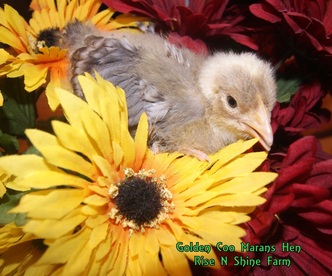
It always pays to know good people and have good friends! But more importantly we should all be a good person and a good friend!
I was blessed again today by a family I met through Craigslist! They don't live that far from me and I met them on Craigslist of all places!They have blessed me and my son more than they will ever know! I have grown to adore them and they are just such good people. They know who they are so I don't have to mention them by name. Sometimes, when you get mentioned by name you don't get all of the blessings in heaven you would be able to get. I want this family to get as many blessings in heaven as they have coming to them! *smile* They saw that I had a need and the filled it in a big way! Today I received Golden Coo Coo Marans eggs from them. I didn't have an incubator to hatch them so they loaned me their incubator. Now I have 42 eggs in that incubator and in my other borrowed incubator (from another friend) I have 56 eggs that are due to hatch in a couple of days.
This family is a perfect example of Christ's love but also how we as "farm families" are supposed to be; helping of each other. We are all in this together. Some people in today's society may say this is "old fashioned" and people aren't that way anymore. I have also heard, "you just can't trust people these days." I am here to tell you that there are lots of people that you can trust these days you just might be looking in the wrong place? Farm families know what it is like to lose animals, struggle, teach kids a better way of living and a healthy way of living. We barter with each other, help each other out, borrow a cup of sugar from our neighbors, take them eggs just because, bake them pies when they move in to the "neighborhood", trade hay for goats, and visa versa. It's a simple way of life but it is also a lot of HARD work! It's not for the meek at heart or the weak in determination. But if me, a farm girl, can do it I believe anyone else can too with the right resources! Sometimes you find the resources, sometimes they find you!
~ Dawn
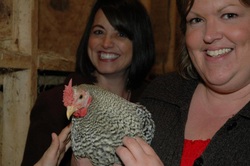 This is Pretty Boy my Dominique Roo that was given to me when I first started The Coop Deville! He is about 6 months old in this picture. This picture was taken last Thanksgiving.
When I moved to my new place there was a lot to learn on the farm. Mainly I was learning about how to raise chickens. How hard could that be? Little did I know. I was new to this chicken farming thing and I got a real life lesson on predator's as soon as I moved in with the chickens.
I went in to feed Pretty Boy and the "girls" one day and Pretty Boy was gone! Vanished into thin air! I looked everywhere for him, tears in my eyes, and I couldn't find him anywhere! My first thought was someone stole him! He is endangered maybe someone wanted him really bad? I had to go to work. I called my boss crying to tell her I would be five minutes late because I couldn't find my rooster! She said it would be ok and I could get another rooster. Of course, I didn't want another roo; I wanted Pretty Boy! Pretty Boy would eat out of your hand, he would peck at my leg until I picked him up! He loved to eat broccoli out of your hand. He was so gentle and kind! I just loved that baby roo!
On my way to work I called a dear old friend and he went to the barn to check out the situation. He called me at work to tell me that he had found Pretty Boy and he was dead in the corner of the barn. He also said he didn't know how I missed him and that there were feathers on the door of the coop as well. I didn't see him through my tears is how I missed him. So now I knew there was a culprit in the barn and I was determined to find it! I went on my lunch break and bought a live trap. I took it home, couldn't figure out how to set it, got some chicken flavored cat food, and called my friend again. He went to the barn, set the trap, and I waited. Not for long! The next day I had a 25 lb. black barn cat in that trap. That cat "came with the barn" when I moved in and I suspected him but some people told me a cat wouldn't take down a chicken like that. Well, they do and if anyone tells you they don't they are wrong!
Two of my old high school friends came over to help me "dispose" of that mean old barn cat. He was meaner than a junk yard dog! I couldn't shoot it! My friend couldn't shoot it! So my old high school girlfriend went out there in a dress, talked to that cat before she shot it! My guy friend and I ran toward the house so we didn't hear the shot but he didn't make it to his car in time and I didn't get in the house in time before the gunshot went off! Let's see, I had lived on this farm for four months before I had to dispose of my first predator!
Little did I know then that I would later lose 14 chickens and a duck to coyotes! At that time in my farm career I would not have been prepared for disposing of coyotes. Farm life has toughened me up some and now I feel ready to protect all of my animals, myself and my son! It is a process and one I am still working through.
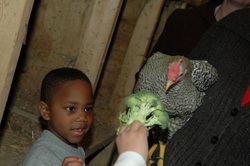 Pretty Boy eating his favorite treat, Broccoli! How did Pretty Boy get his name? My aunt, Betty Shy, used to have a cardinal when she lived in her log cabin. She would whistle every day and say, "here Pretty Boy" and don't you know that cardinal would always come flying up to where she was standing or sitting. I saw this myself on my visits to her home. I always loved this about her and I love this story. I wanted a little piece of that on my farm so I named my favorite roo "Pretty Boy." Thank you, Aunt Betty, for some great childhood memories! I love you!
~ Dawn
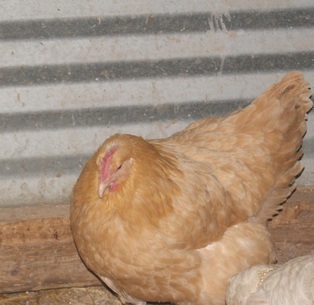 As I was doing a head count of the chicken flock I realized that I was missing 14 chickens! All laying hens and one male white pekin duck! I have a breeding pair of ducks or I should say I did have one. I am missing 15 birds total! I looked in the corn field, in the tall grasses they hide in, behind the barn, in the barn, around the entire property and they were no where to be found. I let my great pyrenees out to herd them up and there were none! I had 28 laying hens for my small egg business and now my flock has been cut in half by COYOTES! There is a new pack in town and I could hear them all talking to each other last night. This is a brand new pack because I haven't heard them all summer until now. There are usually a few coyotes here and there but never this many! I am making preparations to get rid of this problem. Wish me luck?
~ Dawn
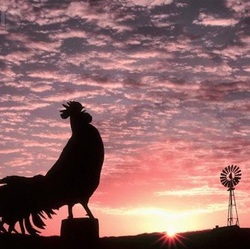 Rise N Shine! Our two acre farm went without a name for a little over a year. I wanted to get the feel of the farm, see what transpired around here and how it felt before I decided on one name. We tried a few out but none seemed to fit. As you can see from the picture at the top of each page we wake up to a beautiful sunrise every morning. This picture was taken on our farm as the rooster's were crowing one fall morning. The farm is especially nice during the changes of season it always reminds me of a new beginning. Each morning is a new beginning given to us from God to make a difference in the world. We can go out and help people make changes in their life, be a better person, grow as a person and we can see the changes. Each new day is full of opportunity for us to better ourselves as human beings and be there for people who are less fortunate than us.
Rise N Shine Farm is a reminder that each new day starts a whole new beginning of something great! Each day we can start over and be or do better than we did the day before. So as the rooster crows each morning, you see the sunrise, or you just rise in the morning ask yourself this question, "What can I do today to make a difference in someone else's life?" To change the world it is done one person at a time.
~ Dawn
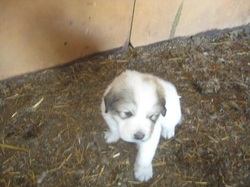 I received this picture today of our new great pyrenees, Glacier. He's so handsome! He is the bright spot in my day today! He is four weeks old and I can't wait to meet him!
I overslept this morning! I woke up at 7:50 am. I jumped out of bed, you know that feeling when you oversleep, the panic you feel when you wake up? I made a flying leap out of bed, got my son up, he got dressed really quick and I got him to school right on time. But then I remembered school starts late on Monday so he was actually 30 minutes early! So I told him he had plenty of time to eat breakfast before school today and how great it was he wasn't really late! I rushed home, got ready, got to work 50 minutes late and I was off to the races!
Work flew by, then on my way to pick up my son, take him to football practice, then go home and cook supper. Hmmm...maybe we will eat at a local restaurant that has my favorite strawberry lemonade and taco salad. Sounds yummy!
Can't wait to get back out into the country from the hustle and bustle of the city and work!
Last night, I sold 5 dozen Coturnix Quail eggs! I really love the Coturnix Quail and they are sooo hardy, good layers, they make a beautiful noise in the barn. I highly recommend any farmer or chicken lover getting these birds to make a nice addition to your farm. I hear they are very good to eat too but I haven't eaten any yet. I am still trying to get up my nerve on that one. It may come one day. *smile* That is all a part of sustainable living isn't it?
My plan is to get two calves and raise them for beef. My fear is that they will both be named, petted, cared for, fed, and then come time to butcher them I won't be able to do it because I will have turned them into pets too! Being raised on a farm but not farming is hard to get used to the idea of raising your own food and eating it. I know it is much better for you. The quality is better and it is healthier so I want to do it. I just hope I have the heart to do it. Time will tell.
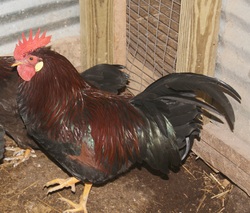 These are the dark brown leghorns that I bought after I sold my Isa Browns. They lay white eggs just like the white leghorns do! Do you know how you can tell what color egg a chicken will lay? You can tell by the color of their earlobe. You can see the white ear on this rooster.
I still had a lot to learn about chickens and farming! What I didn't know didn't hurt me, or did it? I had a dream to have my own farm and become at least 90% self sustaining. I wanted a business which would enable me to hatch chicks, sell eggs, and breed good quality animals to share with others. I had a barn that was a mess and hadn't been used for animals for many, many years. It needed a lot of work and I wasn't even that good with a hammer and nails! Like I said before, I do everything backwards, this is how I learn! I got the animals before the barn was ready for them. That is how I got it all started.
There was a lady at my son's day care that had chickens and a farm in the past but now lived in town. She wanted to help me get my chicken venture started. So her and her 15 year old son came out to the farm and built up the middle chicken coop for the chickens that we got free at the 4H fair. The chicken coop was beautiful and I named it The Coop Deville!
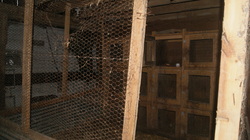 Here is the chicken coop before....
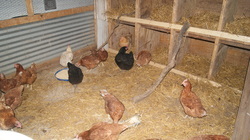 Here is the coop after... NOW it is The Coop Deville! I loved it! It is still gorgeous! To this day I am still grateful for the role that my dear friend and her son played in getting this chicken business started!
What a big difference two people can make in the life of a single farm girl! The chickens loved their new home! We put all of the white leghorns in their new Coop Deville. This is how I found out that White Leghorn chickens can fly really well. You can't see it in this picture but there are holes at the tip top of this coop. When I came back out to the barn to show my friends the new coop the white leghorns had "flown the coop" so to speak and were flying all over the barn. They were in the hay loft, in the barn, "free ranging" you name it! One of the chickens flew on one of my girlfriends back and she about had a stroke right there in the barn! Needless to say, the first tour didn't go so well in the barn. *smile* My other friend's husband helped me get all of the chickens back in their coop. This is how I learned to clip chicken wings! (Still learning everything backwards
To clip chicken wings you use scissors and you clip one wing shorter than the other. This causes the chicken be unbalanced when it tries to fly and it can't fly. I haven't lost a white leghorn chicken due to "flying the coop" since. Notice I only said white leghorn. That bring me to another story that I will tell very soon.
~ Dawn
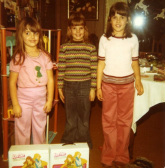 This is my sister, my cousin, and myself in that order from left to right. We were kids in the 70's as if you can't tell from the clothes? Those were the days!
Most people ask me how I got to be a livestock farmer and I usually smile, then tell them my story. Now I am going to tell you. I grew up in the country but my family never farmed. My mom and dad worked really hard every day to provide for myself, my younger brother and sister. They worked really hard and instilled values in me that will never go away. That is how to work hard, love others, love family, and be responsible!
My dad comes from a farm and my grandpa and grandma farmed while he was growing up. He never really talked about life on his farm growing up much and I didn't know what all it entailed. Now, every time I make a mistake or want to do something my dad is a wealth of information! Who knew? I am glad I get to see this side of his life now and we share farming in common.
I started this new venture after living in "town" for 20 years. I needed a change and I longed to live in the country again where I grew up. So I packed up my little two bedroom apartment and my son and I moved to the country in a two story, country house, on two acres, with a big, huge, red barn and lots of possibilities. We were given our first chickens by the local 4H fair. Nineteen, white leghorns, to care for as soon as we moved in and so it began; our new adventure! Boy was it an adventure! Taking care of chickens, how hard can it be, right? I wanted laying hens right away so I also bought 20 Isa Browns from an old Amish Farmer and they quit laying when I got them. I couldn't get them to lay to save my life! I had all kinds of "chicken experts" come in, which were old high school friends of mine, to help me figure this out! They were stumped too. They were used to just having chickens in a coop and they layed eggs! That is what I thought too! Well I was wrong. Apparently, when you move chickens they sometimes quit laying for a good two weeks or more. Mine had lots of feathers missing, they looked diseased, but I later found out that was from the roosters plucking their feathers out when he fertilzed the hens. Their feathers gradually grew back in and they looked more normal. They eventually started laying after I added a roost, and a barrel for them to lay in to have more privacy. Who knew a chicken needed privacy? Not me!
Some people might start small, figure out how to raise chickens, and then get more. Well, not me! I jump right in with both feet to everything that I do. I usually say I do everything backwards such as I get the chickens then I figure out how to raise them. That is how I learn by doing! I sold my first flock of Isa Browns because they weren't laying at even 60% after they were 15 months old. I decided I was feeding them like crazy and they weren't producing enough eggs for my very small egg business. I made a business decision, sold them on craigslist, and got some new chickens. This time I got dark brown leghorns and my white leghorns were about to lay. I think we went two weeks without any hens laying and I had enough eggs to last us that long. This is what started my being interested in various breeds of chickens and the egg color. I decided at this point I wanted a chicken that layed every color of egg that was possible and so my hunt continued for the perfect flock of chickens! 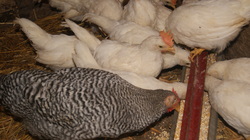 My first flock of chickens; white leghorns and a Dominique Roo someone gave me. HIs name was pretty boy. His story will be published soon.
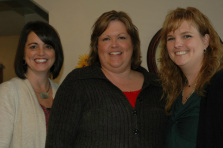 The three girls that used to play restaurant together. We decided that my sister was the waitress while me and my cousin made the "mud pies." My sister was never one to get too dirty! *smile* This is my sister, myself and my same cousin as pictured above. We haven't changed much in ohhhhhhhh some 30 years?
|













 RSS Feed
RSS Feed